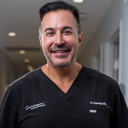Posted underGynecomastia Surgery q&a
How difficult would it be to resolve this severe of a crater deformity? (photo)
Surgery was 5+ years ago and from a seemingly inexperienced general surgeon (I was dumb and broke at that point in the life). Anyway, I now understand the importance of a skilled plastic surgeon but would like some input on how bad this is in the grand scheme of things and how difficult it would to regain a normal appearance on the left side of my chest.
Answers (6)
From board-certified doctors and trusted medical professionals
Dr. Daniel Careaga, MD

Dr. Daniel Careaga, MD
Board Certified Plastic Surgeon
Answer
Dr. J. Timothy Katzen, MD, FACS

Dr. J. Timothy Katzen, MD, FACS
Board Certified Plastic Surgeon
Answer
Dr. Paul M. Steinwald, MD

Dr. Paul M. Steinwald, MD
Board Certified Plastic Surgeon
Answer
Dr. Zoran Potparic, MD

Dr. Zoran Potparic, MD
Board Certified Plastic Surgeon
Answer
Dr. Tek Przylecki, MD, FACS

Dr. Tek Przylecki, MD, FACS
Board Certified Plastic Surgeon
Answer
Dr. Hilton Becker, MD
Dr. Hilton Becker, MD
Board Certified Plastic Surgeon
Answer
More Gynecomastia Surgery Questions
See all Gynecomastia Surgery Q&AWE SEND PRETTY
EMAILS
What’s trending? Who’s turning heads? Which TikTok myths need busting? We’ve got you. No fluff, no gatekeeping—just real talk. Get our free, unfiltered newsletter.